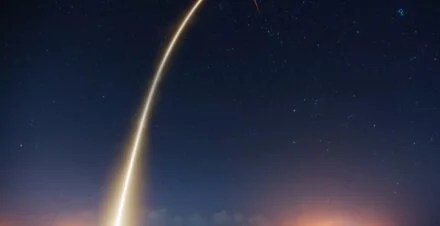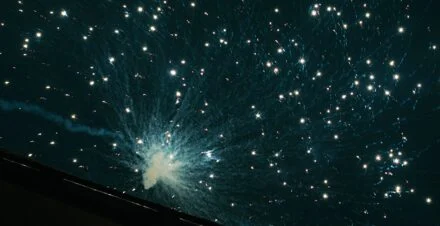The collision risk in low Earth orbit (LEO) can be a confusing mix of terms and equations. To better understand the importance of collision risk for the short-term safety of operational constellations and long-term sustainability of LEO, we will follow an individual space object through a sequence of risk calculations. This process will clarify and highlight the need for continuous monitoring and characterizing of all components of the LEO space population in order to catalyze actions to control the growth of debris.
Key characters in our story
On May 22, 1990, the Soviet Union launched Cosmos 2082, an Electronics Intelligence (ELINT) satellite with a mass of 3,250 kg, into an 850 km circular orbit. The Zenit-2 launch vehicle (also called SL-16) deployed this satellite and the upper stage from this launch vehicle was left in a similar orbit to Cosmos 2082. Cosmos 2082 has the International Designator (INTLDES) 1990–46A (i.e., the primary object of the 46th launch of 1990) and the NORAD ID 20624 (i.e., the 20,624th object cataloged by the 18th Space Defense Squadron of the United States Space Force). The SL-16 rocket body has a mass of 9,000 kg, is roughly 11 m in length, and has a diameter of 4 m. Its INTLDES is 1990–46B and Satellite Number 20625.
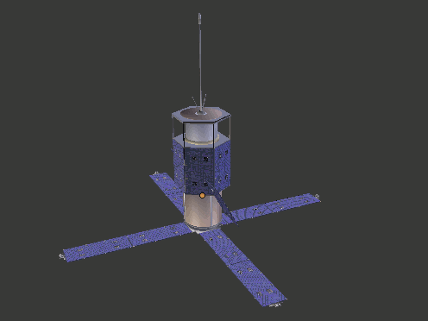
A model of Cosmos 2082, which featured the Tselina-2 system (Public Domain).
The practice of leaving a rocket body along with a deployed payload was used by many space operators in the 1980s and 1990s. Both objects have now been in orbit for over 32 years, circling the globe over 165,000 times. The distance these two objects have traveled is just under eight billion km; this is equivalent to a round trip from the Sun to Pluto and back!

The SL-16 rocket body is similar in mass and dimensions to a school bus — except it’s going 7.5 km/s, has no brakes and a steering wheel.
The plot thickens
On 5 June 2022, the S-16 R/B 20625 was involved in a close approach with another derelict rocket body, the 37 kg Scout X-4 upper stage, deposited in LEO in 1964 by the United States to deploy Explorer 25 (INJUN-4). The Conjunction Analysis Report, provided by LeoLabs, details this conjunction of 500 m (+/- 100 m) miss distance with a relative velocity of 8.7 km/s (i.e., ~17,000 mph), and a probability of collision (PC) of 1.3E-3 (i.e., ~1/800 chance).
While this may seem like a low probability, typically an operational spacecraft in LEO will take evasive actions if an encounter has a PC greater than 1E-5 (i.e., a hundred times less likely than the close approach that occurred in June).¹
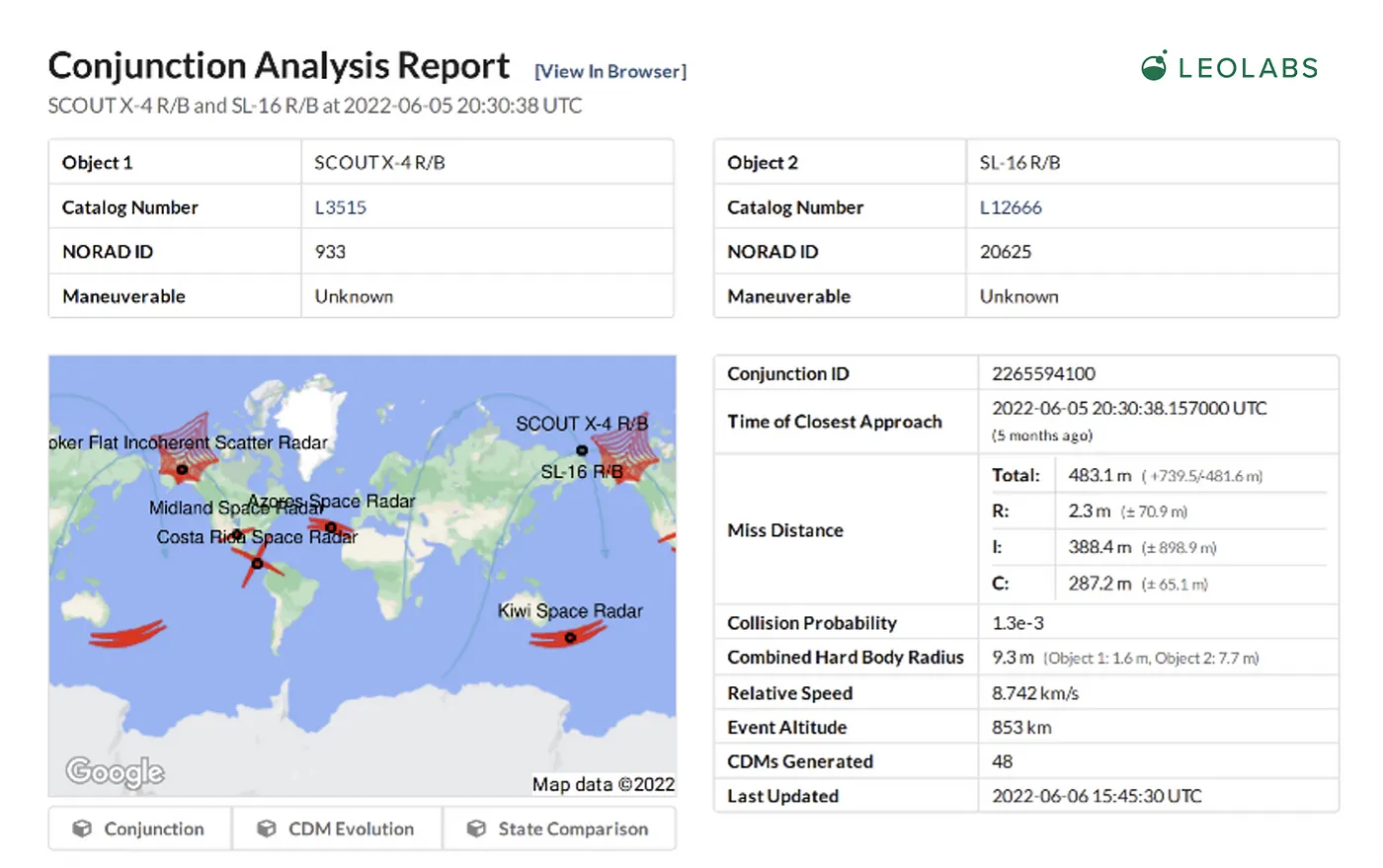
The Conjunction Analysis Report summarizes what is included in a Conjunction Data Message (CDM). The figure below depicts how the CDM provides the PC between two distinct objects for one specific encounter.

Further, so far in 2022, object 20625 has been involved in a total of eight events with a PC greater than 1E-5, shown in the table below from the LeoLabs platform.
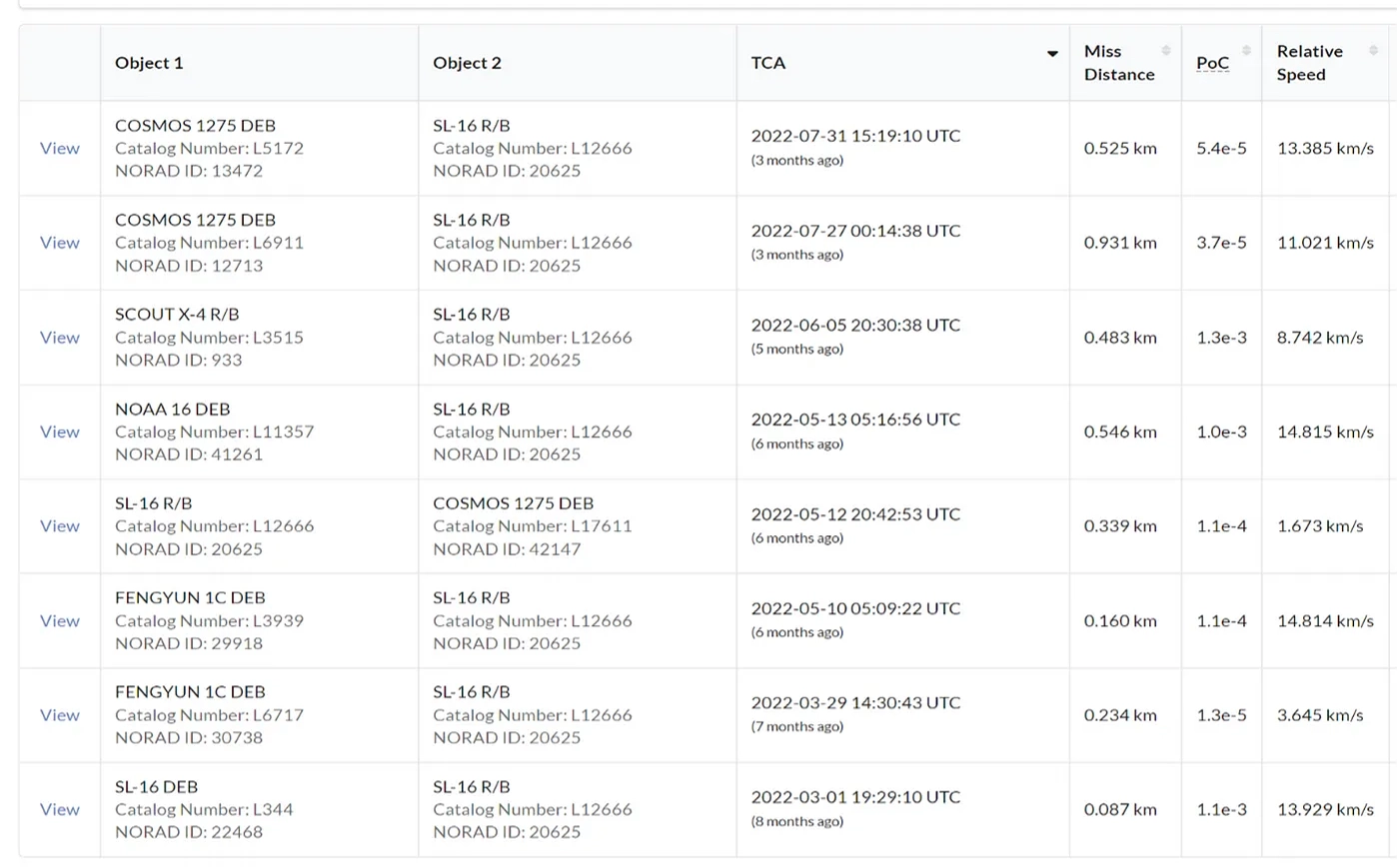
That large number of high PC conjunctions shown above is only the tip of the iceberg. During the first nine months of 2022, there were 298 conjunctions with a PC greater than 1E-6 for this specific SL-16 R/B. The distribution of the objects 20625 is encountering in orbit over time is shown in the figure below, produced by the LeoLabs mapping tool. While most of the encounters are with fragments, there were nine events with operational payloads and two with rocket bodies. This hints at the larger perspective of all objects in the vicinity of our SL-16 RB 20625 posing a collision risk to this massive derelict.
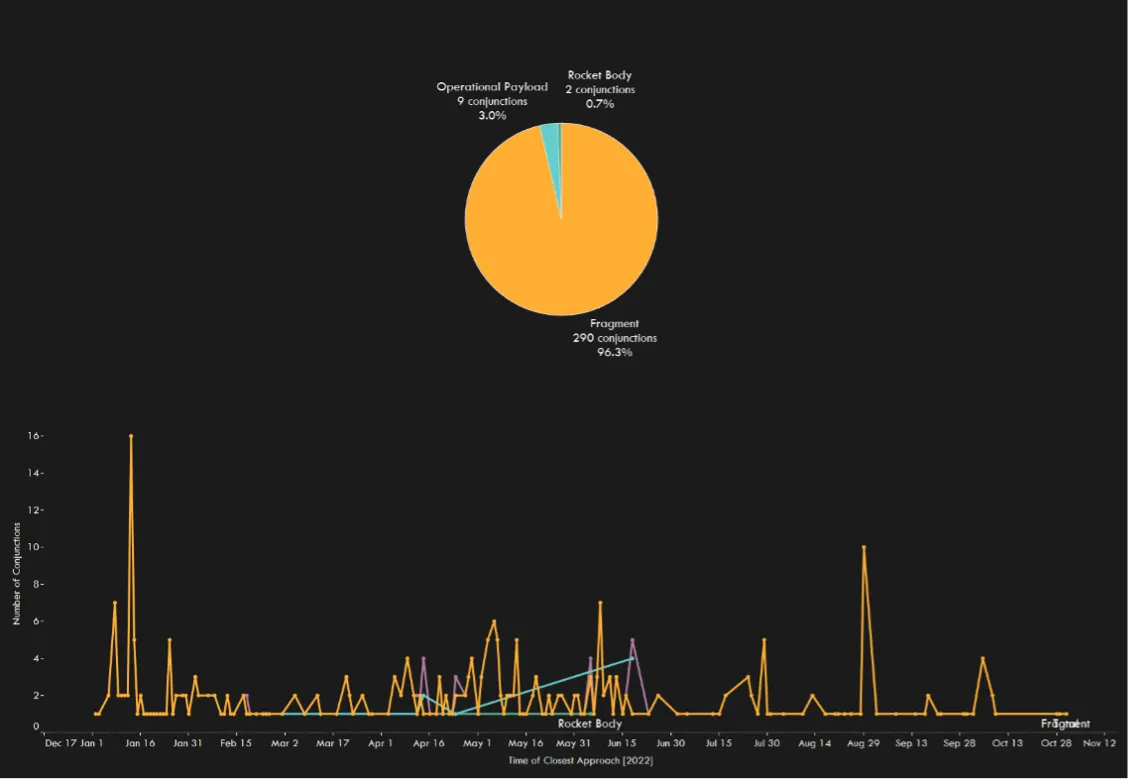
Statistical Probability of Collision (PC)
The statistical PC for a single object from all of the resident space objects that might cross the object’s altitude is determined using an equation that considers the object’s size (i.e., collision cross-section) multiplied by the spatial density of other objects (i.e., number of objects per cubic kilometer) multiplied by the relative velocity between these objects (~12 km/s in LEO).²

LeoRisk, a LeoLabs product, provides a way to determine the statistical annual PC levels and what objects contribute to the collisional hazard for any object in LEO. As shown in the figure below, the types of objects 20625 encounters throughout the course of the year to reach 1.57E-3 PC, statistically, are very similar to the distribution of objects from the CDMs issued during the first nine months of 2022. Note that the summation of the CDM PC values will not necessarily be equal to the statistical PC level over a short time period, such as a year or two. In fact, it may take a decade or more for these values to line up, if at all.
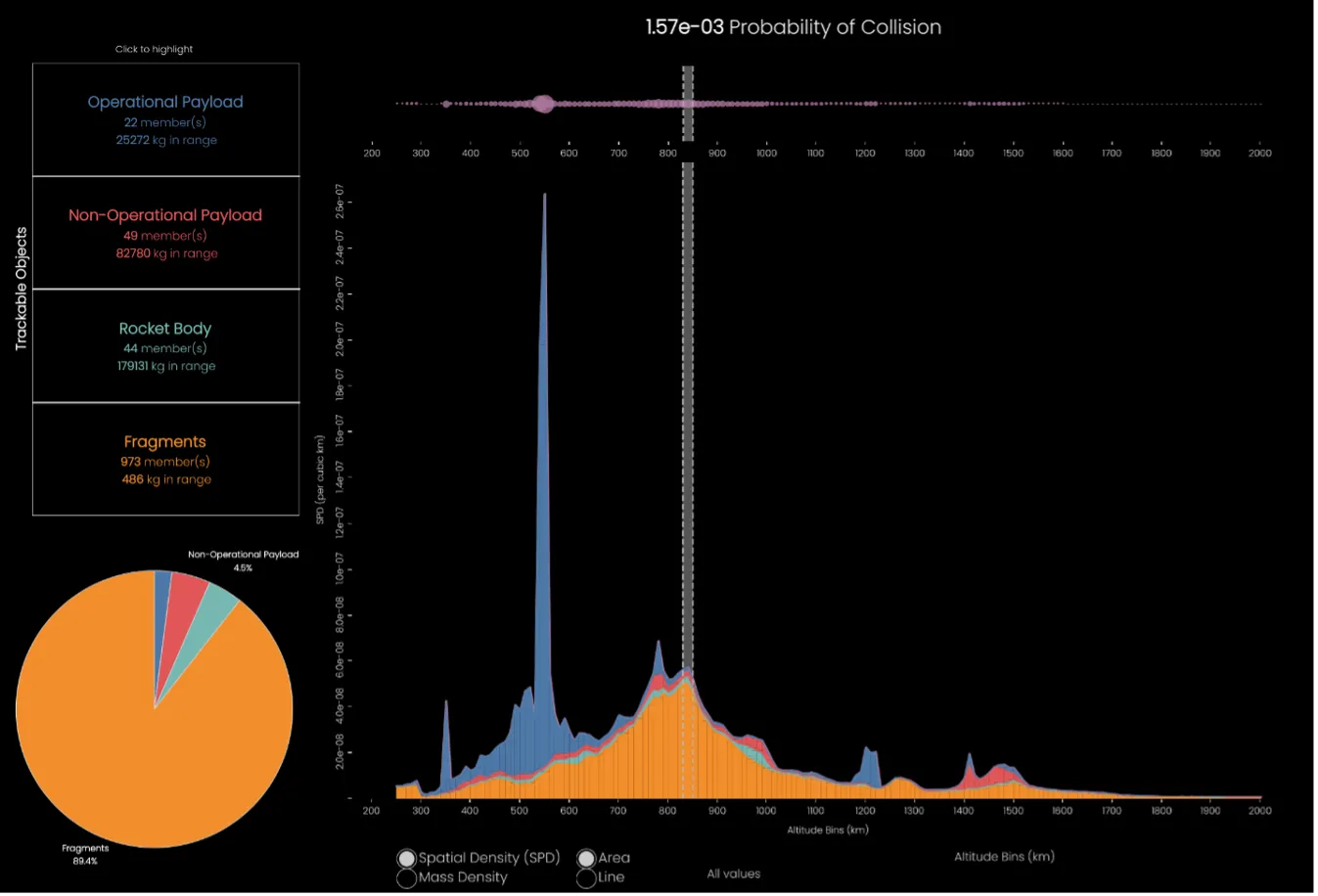
The consequence of some of these events with 20625 may range from minor to very consequential. For example, a fragment impact on 20625 may create hundreds of pieces of debris while a collision between 20625 and the Tselina-2 satellite (20624) that it deployed would likely create over 15,000 cataloged fragments and many more lethal, small debris that are not yet trackable. Now, let’s examine how likely it is for these massive objects (i.e., SL-16 RBs and non-operational Tselina-2 satellites) to collide in LEO.

Cluster 850 as a hotspot in LEO
The original characters in this risk story, 20624 and 20625, were part of a larger deployment by the Soviets Union and eventually, the Russian Federation. In total, from 1985 to 2007, 18 ELINT satellites and their associated 18 SL-16 upper stages were deposited between 825 and 865 km. While our previous collision hazard calculations examined either a single event between two objects against each other (i.e., a CDM) or an annual risk for one object vs all other space objects it could possibly encounter (i.e., statistical PC), a collision rate (CR) can be determined among any subset of objects. In this case, that subset is these 36 massive objects deposited centered around 850 that we call Cluster 850 (C850).
This dynamic is depicted in the figure below.

These 36 objects alone amount to 208,000 kg, which is equivalent to over 50,000 3U CubeSats. CR is a relevant concept when any collision event amongst a population is meaningful.³ In this case, the catastrophic collision between any two objects in C850 would likely create over 15,000 cataloged fragments — nearly doubling the LEO fragment population in one instance. This debris would likely be spread over many hundreds of kilometers. For example, the debris cloud from the fragmentation of the Chinese Feng-yun 1C satellite in 2007 at 860 km has been regularly involved in conjunctions at altitudes as low as 300 km and as high as 1,400 km in 2022. It is also important to note that debris created at these altitudes will linger for centuries.
The current annual collision rate within C850 is 1.7E-3 (i.e., a 1/580 chance each year). The importance of C850, however, is amplified when we remember this ensemble of derelict mass has been whizzing past each other for decades (i.e., to Pluto and back). Taking this into account, the probability that the first collision between these objects could have occurred by 2022 is 5–6%. By 2040, this expectation will increase to 8–9% without any intervention such as removing some of these objects. The 18 SL-16 RBs in C850 have been highlighted on numerous occasions as posing a significant debris-generating potential in LEO and have been identified as 18 of the top 50 objects that should be removed from LEO.⁴
The “big picture”
Satellite 20625’s 32-year transit around Earth highlights how much of LEO is accumulating numbers and mass of debris that are mathematically a ticking time bomb, and the global aerospace community must cooperatively work to manage the situation. The three primary means to control the debris collision risk in LEO are reflected in the three main chapters of our story:
💬 Conjunction Data Messages (CDMs) are the currency for timely and effective space traffic management. While our main character — the massive derelict rocket body — cannot execute collision avoidance maneuvers, most of the over 5,000 operational payloads in LEO can act on these warnings.
⚠️ Statistical probability of collision highlights the need to stop adding debris to LEO (i.e., debris mitigation).
🚀 The collision rate between clusters of massive derelicts amplifies the need for debris remediation (i.e., active debris removal).
The continual discussion of these facts and figures, we hope, will help motivate policymakers, regulators, space operators, and international military services to act responsibly to preserve the space environment for the generations to come. Tamara, a student from Williamston High School in Michigan and a member of the next generation, eloquently stated in a letter to LeoLabs: “The longer that the government waits to help solve this problem, the more debris there will be in orbit.”
The entire “collision risk story” can be captured in the figure below and is representative of the multi-dimensional debris collision risk challenges posed in LEO. Although complicated, these “stories” are important to tell because continual high-frequency monitoring and analytic characterization of conjunction dynamics in LEO can catalyze responsible actions by the global space community—and that’s exactly what we’re working towards at LeoLabs.

Notes:
- So far in 2022, there have been over 20,000 close approaches in LEO where the PC has exceeded 1E-5.
- PC = 1-eλt where λ = collision cross-section (km2)*relative velocity (km/s)*spatial density (#/km3) and t is time (s)
- CR = (N2/2)*collision cross-section (km2)*relative velocity (km/s)*relative velocity (km/s)*time (sec)/Volume of altitude expanse of cluster (km3) where N is the number of objects in the cluster
- McKnight, et al, “Identifying the 50 Statistically-Most-Concerning Derelict Objects in LEO,” 71st International Astronautical Congress (IAC) — The CyberSpace Edition, Dubai, UAE, October 20 and McKnight, D., Dale, E., Bhatia, R., Kunstadter, C., Stevenson, M., and Patel, M., “A Map of the Statistical Collision Risk in LEO”, 73rd International Astronautical Congress, Paris, France, September 2022
This piece was written by LeoLabs Senior Technical Fellow Dr. Darren McKnight with support from LeoLabs’ Data Analytics Team. The featured image is Cosmos 389 ELINT by Brian W. McMullin, 1982 (Public Domain). Cosmos 389 was the first in a series of “ferret” satellites that performed Soviet-era electronic intelligence (ELINT) missions. This satellite was the predecessor to Cosmos 2082, the main character in our story.

